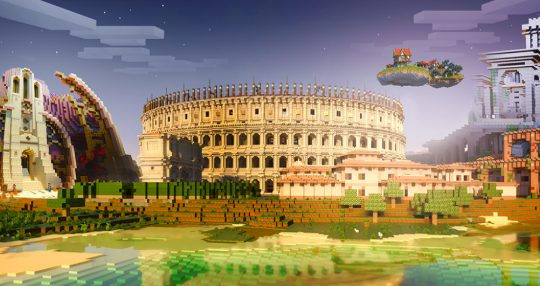Minecraft RTX GPU Requirements Explained

The introduction of ray tracing in Minecraft has transformed the game’s visual landscape, demanding a reevaluation of GPU capabilities for both casual players and server administrators. This article dissects the technical prerequisites, architectural considerations, and optimization strategies necessary to run Minecraft RTX efficiently, with a focus on hosting environments and advanced hardware configurations.
Technical Foundations of Ray Tracing in Minecraft
Ray tracing in Minecraft RTX introduces global illumination, realistic reflections, and dynamic shadows that interact with the game’s voxel-based world. Unlike traditional rasterization, ray tracing calculates light paths individually, creating physically accurate lighting but increasing computational load. This requires GPUs with dedicated ray tracing cores or optimized architectures to handle the parallel processing demands.
Key technical pillars include:
- Support for DirectX 12 Ultimate, which enables feature-level 12_2 necessary for ray tracing pipelines
- Hardware-accelerated ray tracing units to offload intersection calculations from CPU
- High-bandwidth memory subsystems to manage large texture datasets in voxel worlds
Base System Requirements and Architectural Compatibility
While minimum specifications provide a starting point, understanding architectural compatibility is critical for sustained performance, especially in hosting environments handling multiple concurrent sessions.
System Core Requirements
- Operating System: Windows 10/11 (64-bit) with latest updates to ensure driver compatibility
- API Support: DirectX 12 Ultimate implementation, verified through system diagnostic tools
- Memory Subsystem: Minimum 16GB RAM, with 32GB recommended for servers managing complex worlds
GPU Architectural Considerations
GPUs must balance compute power, memory bandwidth, and ray tracing efficiency. Modern architectures incorporate specialized units:
- Ray Tracing Accelerators: Dedicated cores for bounding volume hierarchy traversal
- Deep Learning Super Sampling: AI-based upscaling to maintain framerates without significant quality loss
- Memory Interfaces: Wide buses (256-bit or higher) to reduce latency in large texture streaming
Performance Optimization for Diverse Use Cases
Optimization strategies vary between single-player experiences and multi-user hosting environments, requiring a balance between visual fidelity and resource allocation.
Client-Side Tuning
- Resolution Scaling: Dynamic adjustment using AI-based algorithms to maintain target framerates
- Render Distance Management: Balancing chunk loading complexity with GPU memory capacity
- Graphics Pipeline Tweaks: Adjusting shadow resolution, reflection quality, and ambient occlusion levels
Hosting Environment Optimizations
Server administrators must consider:
- Resource Partitioning: Isolating GPU resources for dedicated Minecraft instances using virtualization tools
- Network Latency Mitigation: Low-latency interconnects to minimize data transfer delays between GPU and storage
- Power Management: Balancing performance profiles for 24/7 operation without thermal throttling
Advanced Hardware Considerations for Colocation Setups
In enterprise-grade colocation environments, hardware selection impacts both performance and scalability:
Multi-GPU Configurations
While Minecraft RTX primarily uses a single GPU, multi-GPU setups can benefit:
- Server-side rendering for distributed world generation
- Load balancing across multiple instances in high-concurrency scenarios
- GPU passthrough in virtualized environments for dedicated resource allocation
Storage and Connectivity Synergies
High-speed storage solutions paired with efficient interconnects enhance GPU utilization:
- NVMe over Fabrics for low-latency texture streaming
- PCIe 4.0/5.0 interfaces to maximize data throughput between CPU and GPU
- Distributed file systems optimized for concurrent voxel data access
Software Ecosystem and Driver Optimization
Modern GPUs rely on sophisticated driver stacks and middleware to expose ray tracing capabilities effectively:
Driver Management Best Practices
- Regular firmware updates to leverage vendor-specific optimizations
- Performance monitoring using built-in tools to identify bottlenecks
- Compatibility testing with server OS distributions to ensure stable operation
API and Middleware Considerations
Developers and administrators should:
- Utilize latest API versions with ray tracing optimizations
- Implement frame pacing technologies to reduce input latency
- Integrate performance telemetry for real-time resource allocation
Future-Proofing Your Setup
As Minecraft RTX evolves, hardware investments should account for upcoming advancements:
- Next-generation ray tracing architectures with improved power efficiency
- Advanced upscaling technologies reducing reliance on raw compute power
- Hybrid cloud-hosting models blending on-premises GPU resources with cloud-based rendering
For hosting providers, this means selecting modular hardware that supports incremental upgrades, ensuring compatibility with future game updates and emerging standards. End-users should prioritize GPUs with strong driver support and active developer communities to extend hardware longevity.
Conclusion: Balancing Performance and Practicality
Running Minecraft RTX effectively requires a nuanced understanding of GPU architecture, software optimization, and environmental considerations, especially in hosting environments. By focusing on architectural compatibility, performance tuning, and future-proofing strategies, both individual users and enterprise administrators can create robust setups that deliver optimal visual experiences without compromising stability or scalability.
As the landscape of ray tracing in gaming continues to evolve, staying informed on hardware advancements and optimization techniques will be key to maximizing the potential of Minecraft’s enhanced visual capabilities. Whether building a personal rig or managing a large-scale colocation setup, the right balance of hardware selection and software fine-tuning ensures a seamless experience in this newly illuminated voxel world.

